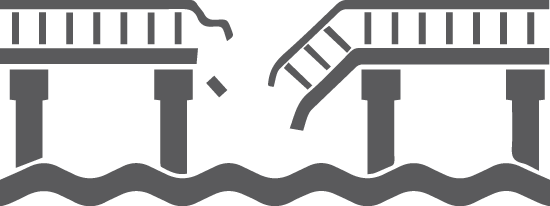If you want to make a civil engineer squirm, ask them about the 1981 Hyatt Regency Collapse. Now, a similar plaque can be hung on the ‘Wall of Shame’, thanks to the deadly bridge collapse at Florida International University in mid-march this year. The full details of what happened are in The Latest on the Deadly Bridge Collapse in Miami or watch the video detailing why concrete can fail at How the Miami bridge broke – Prof Simon.
What Caused the Deadly Bridge Collapse?
- The $14.2 million pedestrian bridge was designed to link the community of Sweetwater with the University campus and was due to be open to the public in 2019
- At the time of the collapse, its cables were being tightened as it was being put through a “stress test”.
- Six people were killed and 10 injured when the 950-ton span pancaked onto a six-lane road
- The crushed cars were stopped in traffic at a red light not far from the bridge
- Two days before an engineer left a voicemail with Florida’s Department of Transportation to say some cracking had been found at one of the concrete spans. The voicemail was unheard as the employee was out of office on an assignment
Side Bar
- In 2012, the construction firm FIGG Bridge Groups was involved in the bridge collapse of the Southern Norfolk Jordan Bridge in Virginia.
- During construction of this bridge, a 90-ton segment fell onto railroad tracks
- The company was accused of failing to properly design a bridge construction system the allegations were made in a lawsuit.
- The issue was later settled and a confidentiality agreement bars the release of details.
What can you do to stop this happening to you?
- Fit for Purpose Design: The HSAW Act 2015 is very clear around the requirements for design safety. Clendons Barristers and Solicitors have written an excellent article on what you are supposed to do Safety in Design: An introduction to the importance of health and safety in design under the Health and Safety at Work Act 2015 which explains it better than I can. The key takeaway from the article is,
“Eliminating hazards at the design or planning stage is often easier and cheaper to achieve than making changes later when the hazards become a real concern in the workplace. Being cognisant of safety upfront during the design process will invariably have a positive impact down the line.”
- Vetting Process: Much like during a recruitment process, always vet the people who are doing your design and construction work
- Public Interface: If you need to stress test a structure during a commissioning phase, make sure no one is underneath it.
- Raising an Issue: If you see a serious issue on someone’s site and call it in, talk to a human, not a machine.
- Follow Up: If someone raises an issue with your infrastructure follow it up. It’s better to be told ‘Yeah, nah, it’s not a problem’ by a suitably qualified engineer then be responsible for killing innocent bystanders.
Let me know if you have any other deadly bridge collapse stories to share or ideas to add to the list to prevent it happening.
Have a safe and productive week,
SB
